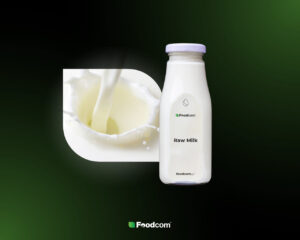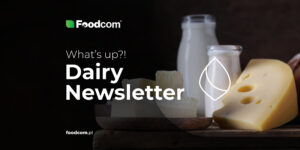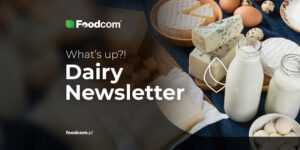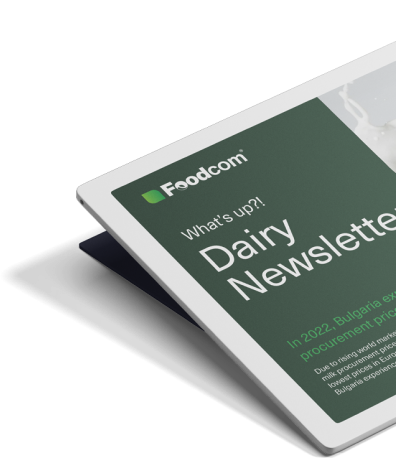- Milk powder prices in Europe continue to fall, with producers struggling with high costs and competition from Oceania.
- The cheese market is seeing declines in Gouda, Edam, Cheddar and Mozzarella, while Emmental remains more stable.
- Butter and cream are under strong pressure, with liquid components and skimmed milk concentrates adjusting downwards.
- The whey and whey protein segment remains balanced, but there are no clear signs of growth.
Welcome Partners!
Welcome back to our newsletter!
Dairy prices in Europe are falling – powders, cheeses and butter are seeing further reductions, while cream and whey are undergoing sharp corrections. In this issue you will find the latest price levels and key market signals, as well as an overview of world news – from the feed crisis in the UK, to a labour dispute in Australia, to trade negotiations between India and New Zealand.
Scroll down for detailed market data and forecasts.
Milk powder
Skimmed milk powder (SMP) markets across Europe continue to weaken, with food and feed prices approaching a narrow range of 2200-2300 EUR/MT. The latest downward adjustment reflects both subdued export demand and the importance of large milk supplies in key producing regions. Activity in the spot market remains subdued as most buyers have assured supplies for the coming months and prefer to delay additional commitments pending further easing.
Full cream milk powder (FCMP) prices are also under pressure, with offers falling to 3850-4000 EUR/MT. The decline in fat content has weakened demand for this product category and competition from Oceania is intensifying, especially after the failure of the GDT auction. European producers, faced with high processing costs, are finding it increasingly difficult to maintain forward price levels, leading to more aggressive bids in the spot market.
Cheese
The European cheese market remains under clear downward pressure. Gouda and Edam cheese prices have fallen again and are now mainly at 3650-3750 EUR/MT on the spot market. Stocks are building up in several plants and demand remains limited, limiting the flexibility of sellers.
Cheddar cheese prices continue to fall and are around 4100-4200 EUR/MT. Recent reductions are bringing many producers closer to breakeven, especially as exports remain low. The price of mozzarella has fallen further to 3550-3650 EUR/MT, where occasional purchases are evident but lack depth.
The price of Emmental cheese remains relatively stable at 4450-4550 EUR/MT, although indirect pressure from the overall market is increasingly felt. The general mood in the cheese segment is tough, and European producers also have to contend with additional competition from Oceania and the United States, which negatively affects export opportunities.
Fats
The European butter market remains under clear pressure. Butter prices have fallen to 6200-6400 EUR/MT, reflecting weaker demand and the impact of high cream availability. Although some retail contracts continue to command higher prices, sellers are finding it increasingly difficult to maintain premiums, especially as more product is being re-directed to butter production.
The AMF segment remains relatively stable, trading within a narrow price range, with balanced interest from both industrial and export buyers. However, the overall situation in the fat market suggests that further adjustments are possible if milk supply remains seasonally high and demand does not pick up.
Fluids
The European liquids market underwent a significant correction. Cream prices have fallen sharply to 7200-7400 EUR/MT, a significant decline from recent peaks. The decline reflects both a weakening in demand and a shift in processing, with some sellers directing volumes back into butter production.
The price of skimmed milk concentrate (SMC) is 2000-2050 EUR/MT, with the German product setting the benchmark. Additional volumes coming into the EU from the UK increase supply, keeping the market balanced but limiting any upward movement.
Raw milk availability remains high for this time of year, putting further pressure on processors who are already facing lower finished product prices.
Whey powder
The European whey market shows limited volatility. The price of sweet whey powder (SWP) of the food grade remains stable at 1000-1050 EUR/MT, while the price of feed grade SWP is slightly lower at 920-940/MT. There is little activity on the spot market and export demand is weak – particularly from Asia – leaving domestic trade unable to absorb available volumes.
The price of whey concentrate is 750-850 EUR/MT (on a dry matter basis). Supply is steady, but processors continue to divert whey streams towards higher value proteins.
WPC 35 is priced at 2600-2700 EUR/MT, reflecting stable demand from feed and food manufacturers. WPC 80 remains stable at 11 600-12 000 EUR/MT, supported by steady orders from the sports nutrition sector.
WPI prices have fallen slightly but are stabilising in the 19 300-19 600 EUR/MT range. Although availability is sufficient, increased processing costs continue to challenge margins.
The price of lactose is around 1200 EUR/MT. Demand from feed and pharmaceutical buyers is present but cautious, limiting the potential for recovery.
Overall, the whey market remains balanced, but lacks dynamism and there is little indication of significant change in the short term.
What’s new?
United Kingdom
The dairy industry is facing increasing challenges as the feed contamination crisis raises concerns about animal health, milk safety and the long-term sustainability of supplies. Experts warn that contaminated feed, which may contain harmful substances, could threaten herd health and reduce milk quality, raising concerns among both farmers and consumers. Industry leaders are calling for swift action to identify the sources of contamination, strengthen regulatory oversight and support farmers in mitigating the crisis, stressing that without coordinated intervention, the crisis could escalate into a serious threat to the economy and public health.
Australia
There is a heated debate in Australia over the pay conditions of Fonterra Oceania workers in relation to the impending $4 billion takeover deal. The United Workers Union argues that workers who have long contributed to the company’s success are receiving worse terms and conditions than their colleagues elsewhere, while Fonterra maintains that its latest offer – a 10 per cent pay rise over three years, extended leave and better benefits – is fair. Striking workers say the offer is inadequate, and as Lactalis prepares to take over Fonterra Oceania’s operations, pressure is mounting on both sides to reach an agreement that safeguards workers’ rights while ensuring production stability.
New Zealand
Negotiations are underway for a potentially landmark dairy deal as India and New Zealand enter the third round of FTA talks (1-7 September 2025.), with Wellington seeking to open up the huge Indian market – the world’s largest consumer and producer of dairy products – while New Delhi remains cautious, protecting its industry with tariffs of 30-60% and favouring imports of only selected value-added products such as whey powder or mozzarella, seeking to balance modernisation with the protection of 70 million small-scale dairy farmers under the ‘Atmanirbhar Bharat’ strategy.
![Powdered milk, cheese, butter – big price corrections in Europe [280th Edition of DAIRY Newsletter] Powdered milk, cheese, butter – big price corrections in Europe [280th Edition of DAIRY Newsletter]](https://foodcom.pl/wp-content/uploads/2023/08/Foodcom_SA_Dairy_Newsletter-1520x760.jpg)






